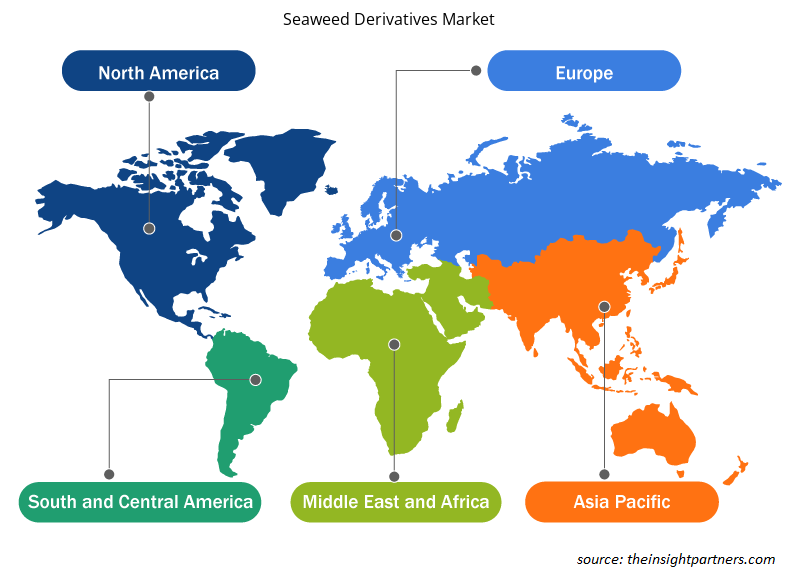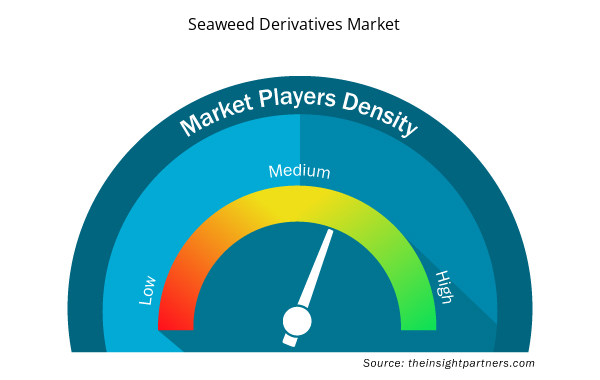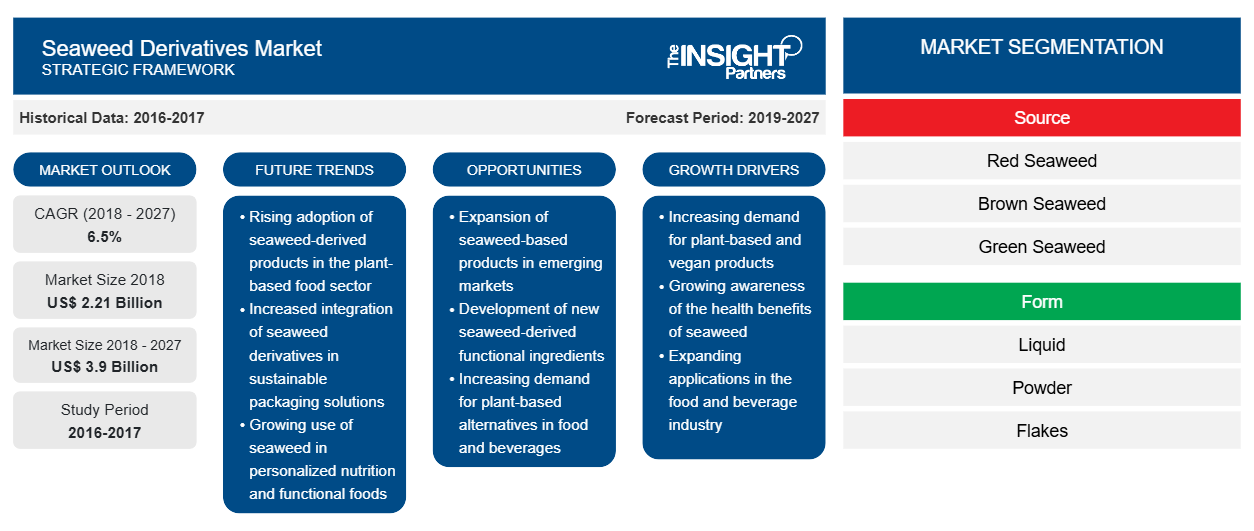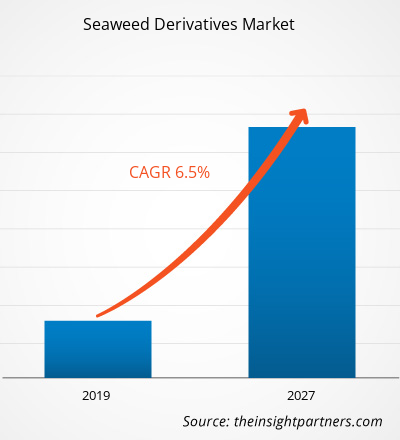2018 年海藻衍生物市场价值为 22.1035 亿美元,预计到 2027 年将达到 39.0391 亿美元;预计 2019 年至 2027 年的复合年增长率为 6.5%。
海藻基本上是红色、棕色和绿色的海洋微藻,其提取物用于园艺作物,具有促进植物生长的作用。海藻的化学衍生物包括脂肪酸和维生素、矿物质营养素、植物和谐素和复合多糖等。海藻的主要衍生物包括藻酸盐、角叉菜胶和琼脂。藻酸盐主要从棕色海藻中提取,而角叉菜胶和琼脂主要从红色海藻中提取。藻酸盐、角叉菜胶和琼脂越来越多地用于食品和饮料、动物饲料和农业等行业。
2018 年,亚太地区在全球海藻衍生物市场中占有最大份额,其次是欧洲和北美。食品和饮料、动物饲料和农业行业的需求不断增长是推动亚太地区市场发展的主要动力。中国、韩国和日本是亚太地区海藻衍生物的主要生产国和消费国。海藻衍生物在食品和饮料行业的更广泛应用推动了市场的发展。海藻衍生物越来越多地被用于肥料中,从而提高作物产量和增加作物强度,有助于增强抗虫能力。消费者对海藻衍生物健康益处的认识不断提高,这极大地促进了海藻市场的发展。此外,有机食品需求的不断增长也推动了海藻衍生物市场的增长。农民对海藻提取的认识较低,阻碍了海藻衍生物市场的增长。
COVID-19 疫情于 2019 年 12 月首先在中国武汉爆发,此后迅速蔓延至全球。截至 2020 年 3 月,中国、意大利、伊朗、西班牙、韩国、法国、德国和美国是确诊病例和死亡人数最多的国家。由于封锁、旅行禁令和企业停业,COVID-19 疫情已影响到各国的经济和行业。全球食品和饮料行业是受疫情影响最大的行业之一,受到供应链中断、技术活动取消和办公室关闭等严重影响。例如,中国是全球制造业中心,也是各行业最大的原材料供应国。由于工厂关闭、供应链受阻和世界经济衰退,COVID-19 导致的整体市场崩溃也影响了海藻衍生物市场的增长。
定制此报告以满足您的需求
您可以免费定制任何报告,包括本报告的部分内容、国家级分析、Excel 数据包,以及为初创企业和大学提供优惠和折扣
- 获取此报告的关键市场趋势。这个免费样品将包括数据分析,从市场趋势到估计和预测。
市场洞察
食品和饮料行业不断增长的需求使全球海藻衍生物市场受到青睐
琼脂、藻酸盐和角叉菜胶等海藻衍生物广泛用于各种食品和饮料产品中。这些衍生物广泛用于各种食品和饮料中,例如冰淇淋、糖浆、午餐肉、婴儿配方奶粉、杏仁奶、生奶油、糖果棒、巧克力奶、咖啡饮料(例如冰咖啡和大豆咖啡饮料)、咖啡奶精、意大利乳清干酪、酸奶、白软干酪和酸奶油等。角叉菜胶用作布丁、巧克力奶、口香糖、果酱和果冻中的增稠成分。此外,角叉菜胶通过延长食品的保质期来减少浪费,而不会降低质量。各种食品,例如蛋黄酱和沙拉酱,如果没有稳定剂的帮助就会分离。因此,角叉菜胶用作蛋黄酱和沙拉酱中的稳定剂。因此,海藻衍生物在食品和饮料行业的广泛应用推动了全球海藻衍生物市场的增长。
来源洞察
根据来源,海藻衍生物市场分为红藻、褐藻和绿藻。2018 年,红藻占全球海藻衍生物市场的最大份额。红藻往往具有最高的蛋白质含量,这是其红色的原因。尽管红藻生活在浅水中,但它们能够承受深水和弱光条件。这些因素推动了红藻衍生物市场的增长。
表单洞察
根据形态,海藻衍生物市场分为液体、粉末和薄片。2018 年,液体部分占全球海藻衍生物市场的最大份额;然而,预计粉末部分在预测期内将实现最快的增长率。褐藻的液体衍生物用于园艺和农业。液体海藻衍生物以高稀释率使用,导致在给定区域内使用的材料量最少。液体海藻衍生物中的活性物质能够影响如此低的温度。
终端用途洞察
根据最终用途,海藻衍生物市场细分为食品和饮料、农产品、动物饲料添加剂、药品等。2018 年,食品和饮料部门占全球海藻衍生物市场的最大份额;然而,动物饲料添加剂部门预计在预测期内将实现最快的增长率。海藻酸盐等海藻衍生物广泛用于烘焙产品、糖果、乳制品、沙拉酱、冰淇淋、奶油和果冻,以及香肠、加工肉类和鱼类。它也用于澄清啤酒和葡萄酒。海藻酸盐是完全有机的,是一种安全的食品应用物质。此外,海藻酸盐溶解在水中时能够使溶液变稠。此外,海藻酸盐加入钙盐溶液中时会形成凝胶。因此,海藻酸盐主要用于沙拉酱和蛋黄酱。
海藻衍生物市场区域洞察
Insight Partners 的分析师已详细解释了预测期内影响海藻衍生物市场的区域趋势和因素。本节还讨论了北美、欧洲、亚太地区、中东和非洲以及南美和中美洲的海藻衍生物市场细分和地理位置。

- 获取海藻衍生物市场的区域特定数据
海藻衍生物市场报告范围
| 报告属性 | 细节 |
|---|---|
| 2018 年市场规模 | 22.1亿美元 |
| 2027 年市场规模 | 39亿美元 |
| 全球复合年增长率(2018 - 2027) | 6.5% |
| 史料 | 2016-2017 |
| 预测期 | 2019-2027 |
| 涵盖的领域 | 按来源
|
| 覆盖地区和国家 | 北美
|
| 市场领导者和主要公司简介 |
|
市场参与者密度:了解其对商业动态的影响
海藻衍生物市场正在快速增长,这得益于终端用户需求的不断增长,这些需求源于消费者偏好的不断变化、技术进步以及对产品益处的认识不断提高等因素。随着需求的增加,企业正在扩大其产品范围,进行创新以满足消费者的需求,并利用新兴趋势,从而进一步推动市场增长。
市场参与者密度是指在特定市场或行业内运营的企业或公司的分布情况。它表明相对于给定市场空间的规模或总市场价值,有多少竞争对手(市场参与者)存在于该市场空间中。
在海藻衍生物市场运营的主要公司有:
- W 水胶体公司
- KIMICA 公司
- 杜邦公司
- 盖利玛公司
- 凯可
免责声明:上面列出的公司没有按照任何特定顺序排列。

- 获取海藻衍生品市场顶级关键参与者概述
全球海藻衍生物市场 – 按来源
- 红海藻
- 褐藻
- 绿海藻
全球海藻衍生物市场 – 按形式
- 液体
- 粉末
- 薄片
全球海藻衍生物市场 – 按最终用途划分
- 食品和饮料
- 农产品
- 动物饲料添加剂
- 药品
- 其他最终用途
公司简介
- W 水胶体公司
- KIMICA 公司
- 杜邦公司
- 盖利玛公司
- 凯可
- 阿尔盖亚
- 西班牙阿尔加斯码头公司, SA
- 嘉吉公司
- 亚瑟·布兰威尔公司
- AGARMEX 公司
- 历史分析(2 年)、基准年、预测(7 年)及复合年增长率
- PEST 和 SWOT 分析
- 市场规模价值/数量 - 全球、区域、国家
- 行业和竞争格局
- Excel 数据集



Report Coverage
Revenue forecast, Company Analysis, Industry landscape, Growth factors, and Trends

Segment Covered
This text is related
to segments covered.

Regional Scope
North America, Europe, Asia Pacific, Middle East & Africa, South & Central America

Country Scope
This text is related
to country scope.
常见问题
In 2018, the seaweed derivatives market was predominant by Asia-Pacific at the global level.Rising concerns about healthy food due to the overweight and obese population as well as rising prevalence of chronic diseases, such as diabetes, hypertension, cardiac issues, and orthopedic diseases, are a few more factors driving the seaweed derivatives market in this region.. Growing awareness about the health benefits and increasing seaweed derivatives usage in the personal care sector is driving the market growth in the region.People in China, Japan, and South Korea have cultivated and harvested seaweed for food and other industrial uses for hundreds of years. Seaweed derivatives are used in textile ink for more than 1000 years. The Asia Pacific has become a lucrative region, which has witnessed an increase in the investment among the manufactures related to several industries such as food and beverage, personal care, and pharmaceutical, amongst others. The growth of these industries is positively expected to expand the demand for seaweed derivatives products in the region.
Among all three segments of source, the red seaweedsegment has led the market in 2018 and is expected to be the dominant segment in the near future.The red seaweed is large branched plants or bushy growths on shellfish and rocks. It makes up the largest group of algae in the plant kingdom, with more species compared to green and brown seaweeds. The main Form of red seaweed is as a source of two hydrocolloids, namely, agar and carrageenan, and the second one is as a source of food. Red seaweed is a marine plant exclusively. Red seaweed tends to possess the highest protein levels, which are responsible for its red color.
The major players operating in the globalseaweed derivativesmarketareW Hydrocolloids, Inc., KIMICA Corporation, DuPont de Nemours, Inc., Gelymar S.A., CP Kelco, Algaia, and Cargill Incorporated, CompañÃa Española de Algas Marinas, S.A., Arthur Branwell & Co., Agarmex, S.A. DE C.V., and among many others.
Trends and growth analysis reports related to Consumer Goods : READ MORE..
The List of Companies - Seaweed Derivatives Market
- W Hydrocolloids, Inc.
- KIMICA Corporation
- DuPont de Nemours, Inc.
- Gelymar S.A.
- CP Kelco
- Algaia
- Compañía Española de Algas Marinas, S.A.
- Cargill, Incorporated
- Arthur Branwell & Co
- Agarmex, S.A. DE C.V
The Insight Partners performs research in 4 major stages: Data Collection & Secondary Research, Primary Research, Data Analysis and Data Triangulation & Final Review.
- Data Collection and Secondary Research:
As a market research and consulting firm operating from a decade, we have published and advised several client across the globe. First step for any study will start with an assessment of currently available data and insights from existing reports. Further, historical and current market information is collected from Investor Presentations, Annual Reports, SEC Filings, etc., and other information related to company’s performance and market positioning are gathered from Paid Databases (Factiva, Hoovers, and Reuters) and various other publications available in public domain.
Several associations trade associates, technical forums, institutes, societies and organization are accessed to gain technical as well as market related insights through their publications such as research papers, blogs and press releases related to the studies are referred to get cues about the market. Further, white papers, journals, magazines, and other news articles published in last 3 years are scrutinized and analyzed to understand the current market trends.
- Primary Research:
The primarily interview analysis comprise of data obtained from industry participants interview and answers to survey questions gathered by in-house primary team.
For primary research, interviews are conducted with industry experts/CEOs/Marketing Managers/VPs/Subject Matter Experts from both demand and supply side to get a 360-degree view of the market. The primary team conducts several interviews based on the complexity of the markets to understand the various market trends and dynamics which makes research more credible and precise.
A typical research interview fulfils the following functions:
- Provides first-hand information on the market size, market trends, growth trends, competitive landscape, and outlook
- Validates and strengthens in-house secondary research findings
- Develops the analysis team’s expertise and market understanding
Primary research involves email interactions and telephone interviews for each market, category, segment, and sub-segment across geographies. The participants who typically take part in such a process include, but are not limited to:
- Industry participants: VPs, business development managers, market intelligence managers and national sales managers
- Outside experts: Valuation experts, research analysts and key opinion leaders specializing in the electronics and semiconductor industry.
Below is the breakup of our primary respondents by company, designation, and region:

Once we receive the confirmation from primary research sources or primary respondents, we finalize the base year market estimation and forecast the data as per the macroeconomic and microeconomic factors assessed during data collection.
- Data Analysis:
Once data is validated through both secondary as well as primary respondents, we finalize the market estimations by hypothesis formulation and factor analysis at regional and country level.
- Macro-Economic Factor Analysis:
We analyse macroeconomic indicators such the gross domestic product (GDP), increase in the demand for goods and services across industries, technological advancement, regional economic growth, governmental policies, the influence of COVID-19, PEST analysis, and other aspects. This analysis aids in setting benchmarks for various nations/regions and approximating market splits. Additionally, the general trend of the aforementioned components aid in determining the market's development possibilities.
- Country Level Data:
Various factors that are especially aligned to the country are taken into account to determine the market size for a certain area and country, including the presence of vendors, such as headquarters and offices, the country's GDP, demand patterns, and industry growth. To comprehend the market dynamics for the nation, a number of growth variables, inhibitors, application areas, and current market trends are researched. The aforementioned elements aid in determining the country's overall market's growth potential.
- Company Profile:
The “Table of Contents” is formulated by listing and analyzing more than 25 - 30 companies operating in the market ecosystem across geographies. However, we profile only 10 companies as a standard practice in our syndicate reports. These 10 companies comprise leading, emerging, and regional players. Nonetheless, our analysis is not restricted to the 10 listed companies, we also analyze other companies present in the market to develop a holistic view and understand the prevailing trends. The “Company Profiles” section in the report covers key facts, business description, products & services, financial information, SWOT analysis, and key developments. The financial information presented is extracted from the annual reports and official documents of the publicly listed companies. Upon collecting the information for the sections of respective companies, we verify them via various primary sources and then compile the data in respective company profiles. The company level information helps us in deriving the base number as well as in forecasting the market size.
- Developing Base Number:
Aggregation of sales statistics (2020-2022) and macro-economic factor, and other secondary and primary research insights are utilized to arrive at base number and related market shares for 2022. The data gaps are identified in this step and relevant market data is analyzed, collected from paid primary interviews or databases. On finalizing the base year market size, forecasts are developed on the basis of macro-economic, industry and market growth factors and company level analysis.
- Data Triangulation and Final Review:
The market findings and base year market size calculations are validated from supply as well as demand side. Demand side validations are based on macro-economic factor analysis and benchmarks for respective regions and countries. In case of supply side validations, revenues of major companies are estimated (in case not available) based on industry benchmark, approximate number of employees, product portfolio, and primary interviews revenues are gathered. Further revenue from target product/service segment is assessed to avoid overshooting of market statistics. In case of heavy deviations between supply and demand side values, all thes steps are repeated to achieve synchronization.
We follow an iterative model, wherein we share our research findings with Subject Matter Experts (SME’s) and Key Opinion Leaders (KOLs) until consensus view of the market is not formulated – this model negates any drastic deviation in the opinions of experts. Only validated and universally acceptable research findings are quoted in our reports.
We have important check points that we use to validate our research findings – which we call – data triangulation, where we validate the information, we generate from secondary sources with primary interviews and then we re-validate with our internal data bases and Subject matter experts. This comprehensive model enables us to deliver high quality, reliable data in shortest possible time.


 获取此报告的免费样本
获取此报告的免费样本